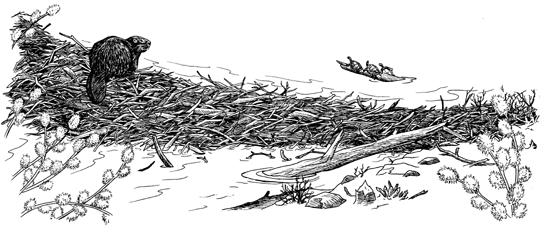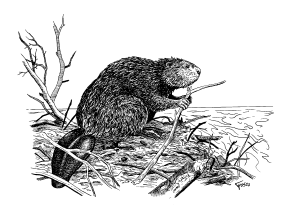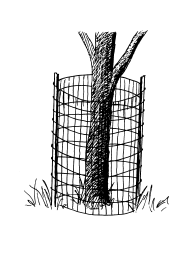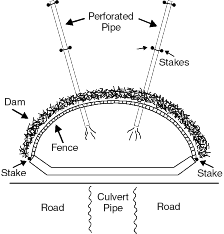Beaver
Castor canadensis
Introduction
The beaver has played an important role in the ecological and cultural heritage of North America. For thousands of years beavers have created and enhanced wetlands across their range, benefiting a variety of wildlife species. Native Americans used beavers extensively for food, medicine and clothing. It was the value of the beaver pelt, created by high demand in Europe, that drove early trappers and fur traders to explore this country. The outposts they created became some of the earliest settlements and trading centers that helped spur settlement across the continent. Beaver pelts became a medium of exchange between Native Americans and settlers. Pelts were shipped to Europe where they were made into a high quality felt and fashioned into hats. The demand resulted in the intensive trapping and hunting of beavers. This unrestricted take of beavers, along with the deforestation that followed European colonization, eliminated the animal throughout much of its range in North America. However, with the establishment of wildlife laws in the early 1900s, the regrowth of forested habitats and subsequent restoration efforts by wildlife managers, beavers have made a remarkable recovery.
Beavers were common in Connecticut when the first colonists arrived. However, by the mid-1800s, with no regulations restricting when and how many beavers could be trapped, the species was extirpated from the state. In 1914, a pair of beavers was relocated to Union in an effort to return beavers to Connecticut. By the 1950s, after additional releases, thriving beaver populations could be found in some areas of the state. Connecticut’s beaver population was well established by 1961 when a regulated trapping season was instituted to address the growing number of beaver damage complaints.
The DEEP Wildlife Division receives hundreds of complaints about beaver damage each year. This number is expected to increase as beaver populations continue to grow and human development encroaches on suitable habitat. Each year, more Connecticut citizens and communities are faced with the challenge of coexisting with beavers. This challenge involves efforts to minimize the problems beavers cause while also realizing the benefits of the wetlands these animals create and enhance. The Division’s goal is to maintain a healthy beaver population at a level compatible with current land use patterns and available habitat.
Description
The beaver is the largest rodent found in North America. Adults can weigh anywhere between 30 to 65 pounds and measure from 24 to 36 inches, plus a tail of 12 to 18 inches. With its webbed hind feet with clawed toes, rich brown fur (which is both waterproof and insulating) and a unique, paddle-shaped, scaled, hairless tail, the beaver is well-adapted to living in a semi-aquatic environment. Except for swollen mammary glands on nursing females, the sexes are indistinguishable in the field.
Range
The beaver’s range includes most of the forested regions of North America, from Alaska across Canada, and as far south as central California, northern Nevada, northern Mexico, the Gulf coastal plain and extreme northern Florida.
Habitat and Diet
Beavers can be found inhabiting rivers, streams, lakes, farm ponds, swamps and other wetland areas. They feed on the leaves, shoots, twigs, roots and outer bark of trees and shrubs. Preferred woody plants include aspen, willow, birch, ash, alder and apple, although beavers will use any type of tree or shrub species if preferred foods are scarce. A variety of aquatic plants, like water lilies and pond weeds, and other plants, like sedges and grasses, are consumed during summer.
Life History
Beavers are monogamous, having only one mate during the breeding season and often for life. Breeding occurs in midwinter and, after a gestation period of 100 to 110 days, a single litter of two to five kits is born in May or early June. At birth, the kits are well-furred and possess fully developed teeth. At two to three weeks of age they begin to eat vegetation and are weaned by about six weeks. The young remain with the adults as a family group or colony until their second year. At that time, the adults drive the young beavers out of the territory, forcing them to migrate and search for mates and unoccupied habitat in which to establish a new colony.
Habits
Beavers are best known for their unique dam-building ability, which enables them to modify the habitat to meet their needs. By cutting sticks and branches and shoving them into the stream bottom and then piling mud and other debris on top, beavers are able to dam a stream and create a pond, or beaver flowage. The flowage provides beavers access to food and protection from terrestrial predators. Water in the flowage must be deep enough to provide a zone of unfrozen water below winter ice. Beavers may also try to dam the outlets of man-made ponds and lakes. They create dams through instinct and in response to the sound and, to a lesser extent, the motion of running water.
A dome- or teepee-shaped lodge is constructed by beavers out of sticks and mud within the wetland, upstream from the dam. The lodge contains a dry inside chamber which provides cover from the elements and a place to raise young. There are usually several underwater entrances to the lodge. Beavers also may build dens along rivers by digging underneath overhanging root masses or into the bank. The entrance to a bank den may be covered with sticks and mud.
Beavers are active year round. They are mainly nocturnal, but are sometimes observed during daytime. Activity is concentrated in the vicinity of the lodge and dam, but, if necessary, beavers may travel several hundred feet from the water in search of food and materials for lodge and dam maintenance. In the fall, a cache, or feed bed, is usually placed just outside of the lodge by anchoring sticks and branches in the muddy bottom. The beavers will feed on this food supply during winter when the pond or flowage is iced over.
Territorial by nature, beavers will not tolerate other beavers within their colony’s home range. An established colony in midwinter typically is comprised of an adult pair, two to four kits and two to four yearlings (18 months old). Established colonies are occasionally forced to move if their food supply is depleted, but this may take many years, depending on the amount of food available to the colony.
Interesting Facts
Beavers use their tail as a support when standing, a rudder when swimming and a warning device for other beavers when slapped on the water. Fat also is stored in the tail to provide a beaver with energy during winter.
When under water, thin membranes protect the beaver’s eyes and internal valves automatically close within the ears and nose. The lips seal tightly around the incisors, an adaptation for feeding underwater. Like all rodents, a beaver's incisors constantly grow.
Beavers have a pair of large scent glands, located near the anus, which produce castoreum oil that they deposit on scent mounds. Castoreum oil has been used as an ingredient in some perfumes. Another pair of glands near the abdomen secretes an oil that is used in grooming. A specialized toenail on each hind foot acts as a comb to spread the oil over the fur. Pelts are considered prime during winter, when the fur is thickest and most valuable. Today, pelts are used in making coats, hats, blankets and other accessory garments, and the meat is sometimes consumed by those who trap beavers.
Benefits
Beaver ponds and their associated wetlands provide habitat for a wide variety of animals, such as insects, spiders, frogs, salamanders, turtles, fish, ducks, rails, bitterns, flycatchers, owls, mink and otters. Dead standing trees killed by flooding provide preferred nesting habitat for colonies of great blue herons and cavity-nesting birds, such as the wood duck and hooded merganser. Beaver ponds also filter and trap sediments and excess nutrients, serve as water storage and recharge areas, and provide opportunities for canoeing, fishing, wildlife observation and waterfowl hunting.
Beaver/Human Conflicts
Beaver/human conflicts have been increasing in recent years due to human encroachment on wildlife habitat and a growing and expanding beaver population. Because beavers have the ability to build dams to impound water, they can dramatically alter the environment in which they live. The problems beavers can cause fall into two main categories, tree cutting and flooding. In some cases, beaver activity can threaten property, agricultural crops or public health and safety.
Beaver dams also may negatively affect other natural resources. For example, dams can serve as barriers to migrating fish and cause inundation and siltation of rare plant and animal habitats.
There are also instances when landowners are unwilling to tolerate any beaver activity on or near their property. Unfortunately, there are no known repellents that are effective against beavers and harassment generally does not cause beavers to abandon a site. In rare instances, such as when a young beaver has not established a territory, continual removal of dam material may persuade it to abandon the site (see Breaching of Dams).
In an effort to assist landowners with beaver conflicts, following are descriptions of a number of options that may help alleviate problems caused by beavers.
Tolerance: In many instances, people experience relatively insignificant beaver damage, such as the cutting of trees around a pond or lake or the flooding of an existing wetland area. The beavers are simply doing what is natural and tolerating that activity is part of coexisting with wildlife. The changes that occur when beavers flood an existing wetland, dam a stream or flood standing trees may be aesthetically unpleasant to landowners. However, people should realize that wetlands are dynamic systems that change over time. The Wildlife Division encourages landowners to develop a tolerance and appreciation of beavers and the benefits they provide for wildlife and humans alike.
Protecting Trees and Shrubs: The most effective way to protect trees and shrubs from being cut by beavers is to place heavy-gauge fencing with a mesh opening of no more than 2-inch x 4-inch around the base of the plant, six inches away from the trunk and extending to a height of four feet. (Chicken wire will not deter the powerful chewing of beavers.)
Exclusion Fencing at Culverts*: In many cases, beavers cause flooding of roads and adjacent land when they directly plug a culvert. In some cases, this can be prevented by staking a strong woven wire fence, 10 to 15 feet in front of the culvert, which physically prevents the beavers from accessing and plugging the culvert. Ideally, the beavers build a new dam against the fence and the culvert remains open and continues draining water that spills over and through the fence and beaver dam. Factors such as water depth, topography and wetland substrate need to be assessed before placing a fence in front of a culvert.
Water Level Control Devices*: In certain situations a water level control device (WLCD) may be effective in reducing flooding to a tolerable level for landowners while maintaining suitable beaver habitat. "Water level control device" is a term used for any device placed through a beaver dam to drain water from the flowage. Plastic perforated pipes, wooden boxes with mesh bottoms, perforated aluminum culverts and culverts made from layers of mesh are all types of WLCDs.
A WLCD minimizes the sound and motion of running water. Ideally, beavers can continue their activities but should not be able to plug the device. Therefore, water can still pass through the device, resulting in a lower water level. The proper installation and maintenance of WLCDs are critical to their success. It is important that entrances to the lodge remain under water and a minimum water depth be maintained to provide sufficient habitat for the beavers if the wetland freezes during winter. Also, landowners must still be willing to tolerate some flooding, especially during storm events.
Control devices are not useful in all situations. Topography, depth of the water behind the dam, number of potential dam sites and watershed size must be considered when determining the applicability of WLCDs. Their use may address a site specific problem, however, the overall beaver population is not reduced.
In certain situations WLCDs can be used in conjunction with fencing to exclude beavers from a culvert and also regulate the water level.
Combination Exclusion Fencing and Beaver Pipes

Breaching of Dams*: Beaver dams may be breached when water needs to be drained from a site prior to dam removal, before WLCDs or exclusion fencing are installed or to temporarily relieve flooding that cannot be tolerated. If breaching is done as an interim measure to relieve flooding until the beavers are harvested during the trapping season, it will need to be done on a regular basis because the beavers will rebuild the dam each night. The breaching of dams should only be undertaken when a more effective solution is not currently possible, as there can be negative environmental consequences, including the alteration of wildlife habitat, downstream siltation and erosion. Breaching should be done with extreme caution due to the possibility of downstream flooding and damage.
*The installation of any water level control device at a culvert or modification of a beaver dam in any way, including breaching or removal, are considered regulated wetland activities and must be approved by the local inland wetlands commission. All installations require regular maintenance.
Trapping: In situations when the presence of beavers cannot be tolerated or the landowner wishes to control the number of beavers on his property, trapping during the regulated winter trapping season is the most effective solution (consult the current Connecticut Hunting and Trapping Guide for trapping season information). Licensed trappers will often voluntarily assist landowners by harvesting beaver during the trapping season.
The results of the trapping season are monitored by a mandatory pelt-tagging program. The season dates are established to harvest beavers at a time of the year when the fur is of greatest value, thus managing the population as a renewable natural resource. Special authorizations to trap beaver outside of the regulated season may be issued by the DEEP Wildlife Division when beaver activity threatens public health and safety or causes damage to agricultural crops.
Population Management
Removing nuisance beavers by live-trapping is not considered a viable option for alleviating beaver problems in Connecticut. This costly technique only serves to move a problem from one site to another. In addition, there are few unoccupied areas where beavers can be moved and not cause another problem. Relocated animals seldom stay in the area where they are released. Most importantly, moving beavers does not reduce the overall beaver population and, thus, does not reduce the number of complaints and damage.
While exclusion fencing and WLCDs may remedy site-specific beaver problems, these techniques will not curb beaver population growth. In Connecticut, there is little natural predation or disease to control beaver populations. Bobcat, coyote, otter and mink may prey on beaver kits and, occasionally on adults, but natural predation does little to reduce the overall population of beavers. Some beavers are hit by vehicles or die due to natural accidents, injuries or disease, but none of these sources of mortality are significant. Historically, the Eastern timber wolf was considered a major predator of beavers. However, wolves were extirpated shortly after the arrival of the colonists and are not likely to return to the highly-developed eastern landscape. Today, humans remain the primary predator of beavers and, thus, the main factor controlling their population growth. The annual removal of beavers during the regulated trapping season is the best long-term solution to maintaining a balance between beaver populations, suitable beaver habitat throughout the state and human land uses.
The DEEP Wildlife Division provides technical assistance to individuals experiencing problems associated with beaver activity. The options available will depend on the time of the year and the nature and severity of the problem. For more information, contact the Wildlife Division at deep.wildlife@ct.gov or call 860-424-3011.

The Technical Assistance Informational Series is 75 percent funded by Federal Aid to Wildlife Restoration - Pittman-Robertson (P-R) Program. The P-R Program provides funding through an excise tax on the sale of sporting firearms, ammunition, and archery equipment. The remaining 25 percent of the funding is matched by the Connecticut Wildlife Division. (rev. 1/17)

